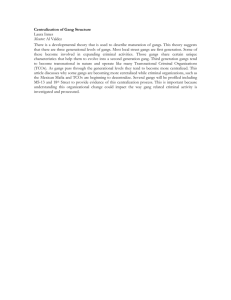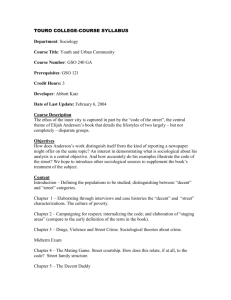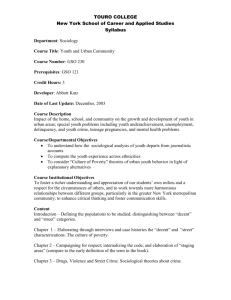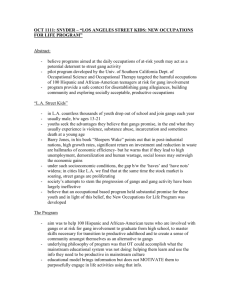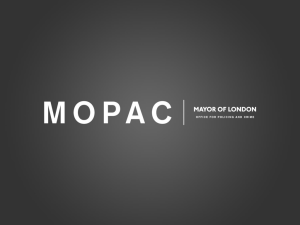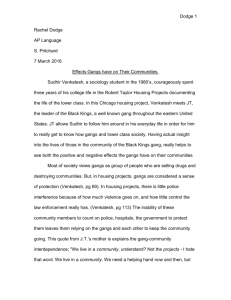Gang Crisis
advertisement
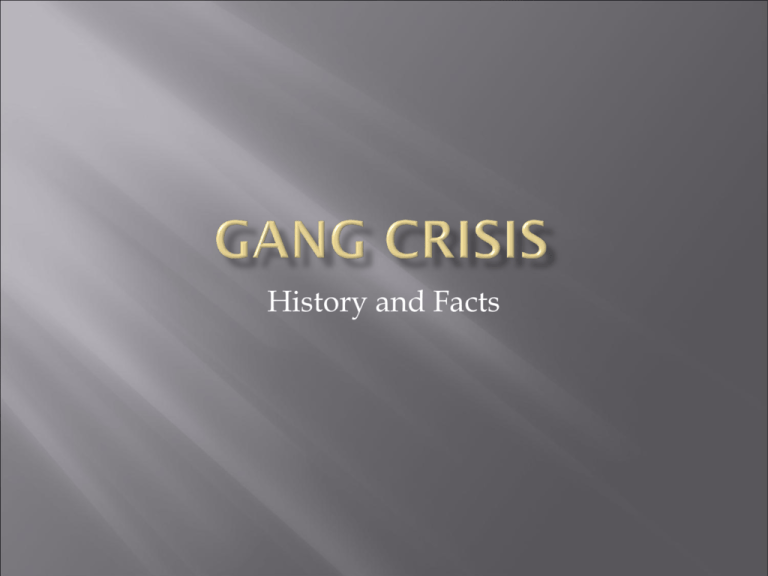
History and Facts Gangs have been in existence for as long as there have been inhabitants of this world. The word thug dates back to India in the year 1200 AD and it refers to a gang of criminals (Thugz) that roamed the country pillaging towns in their course. These Thugz had their own symbols, hand signs, rituals and slang. In the United States, we grew up with tales of our own form of thugs like pirates and gangsters, therefore, gangs, undoubtedly, are not a new concept. Throughout the 1800's, Americans were fascinated with gangs and gangsters. The James Gang, Billy the Kid and other outlaws, legend has it, ruled the Wild West. As the late 1800's roared in, the new generation of gangs and gangsters was created out of the new immigrants. Irish gangs like the Whyos, Dead Rabbits and Plug Uglies, and Jewish gangs like the Monk Eastman Gang terrorized New York City streets. The most notorious gang during this era formed in New York City during the late 1890's and early 1900's. This gang, called the Five Points Gang, because of its home turf being situated in the Five Points (Bowery) Section of Lower Manhattan, would change the mold of the American outlaw forever. The Five Points Gang, led by Italian immigrant, Paolo Antonini Vaccarelli, also known as Paul Kelly and his second in command, Johnny Torrio, was the most significant street gang to form in the United States, ever. Johnny Torrio, who became a significant member of the Sicilian Mafia (La Cosa Nostra) recruited street hoodlums from across New York City to the Five Points Gang. The Five Points Gang became the Major League to many young street gangsters and a farm club for the Mafia. The most notorious recruit into the Five Points Gang was a teenaged boy of Italian descent who was born in Williamsburg, Brooklyn in 1899 to immigrant parents. His name was Alphonse Capone, better known as Scarface. He became a member of the James Street Gang, which was a minor league of sort, to the Five Pointers. One of Capone's childhood friends, and fellow member of the Five Points Gang, was another street thug named Lucky Luciano. In 1919, while being sought by authorities in connection with a gangland murder in New York, Al "Scarface" Capone moved to Chicago when summoned by Johnny Torrio. Torrio needed his assistance in maintaining control of Chicagoland mob territories. Al Capone, eventually became the most violent and prolific gangster in Chicago, if not, the United States, law enforcement has ever experienced. The Al Capone style of gangster has molded the American gangster experience. As will be illustrated later, it is alive today in our street gangs from a variety of backgrounds and races. As street gangs, influenced by mobsters such as Capone, flourished during the 1920's and 30's gangs became a symbol of lower income neighborhoods and ethnic ghettos. America's new immigrant communities and ghetto neighborhoods saw their youth forming gangs. African Americans, Asians and Hispanics made up the majority of street gangs that sociologists would research but the majority of all communities were experiencing street gangs in some degree. During the early 1940's, Mexican gangs formed along the west coast of the United States. As the late 1940's and 50's came along, gangs like the Latin Kings and Vice Lords were formed in Chicago, Illinois. With civil strife and disenchantment abound during the 1960's, African American street gangs formed in large urban cities such as Chicago, Los Angeles and New York. New York street gangs formed under names like the Savage Skulls, La Familia and Savage Nomads. Another New York Street gang during this time known as the Rampers has recently realized the infamy of one its members who is contemporarily known as Sammy "the Bull" Gravano. By the late 1960's and early 1970's, Crips gangs in Los Angeles were so violent and entrenched in ghetto neighborhoods that rival Bloods gangs formed to challenge the strength of the Crips. Meanwhile, Chicago experienced the creation of the Black Gangsters, Devil's Disciples and Black P Stone Rangers, to name a few. The late 1970's and early 1980's paved the way for creation of national gang alliances, expansion of national drug networks and the glorification of gangsters with movies like Colors and Scarface. By the late 1980's and early 1990's, drug networks were in full swing. Drug importation from Southeast Asia and Colombia were at its peak. The United States becomes known as the number one drug consumer in the world. Street gangs develop into drug gangs with businesslike operations. Violence becomes standard operating procedure for these gangs. During this time, gangs are spreading like wildfire. Super Gangs, like the Latin Kings, Bloods, Crips and Gangster Disciples have spread their influence across America. Major cities suffered from the violence connected to these gangs. During the mid 1990's, crime rates begin to plummet across the nation. Despite the decrease in crime, street gangs were forming at a high rate. Each year, the number of gangs and gang members reported in surveys increases. Major cities across the United States develop strategies to combat gangs within their boundaries. Ironically, statistics show the suburban gang situation to have the greatest increase. By the late 1990's, Super Gangs (large, multi cultural/multi-state street gangs) become well entrenched in many American communities despite the steady falling crime rate. Law Enforcement efforts now target gangs across the country and achieving great results. In the year 2000, street gangs were estimated to show a membership of nearly one million members. Some experts estimated one million by the year 2001. Now, gangs can relate to their own glorification in the many gangster rap music and videos flooding the media. This has given them fame rather than infamy. It is apparent in today's clothing and language of our youth how much gangs have influenced our culture. Emulation of the old gangsters, their names, colloquialisms and their practices are being acted out in the streets of our cities and towns. Gang members are referring to themselves as made men and John Gotti or Al Capone. Today's gangsters study the ways of past gangsters and ready themselves for the new generation.
